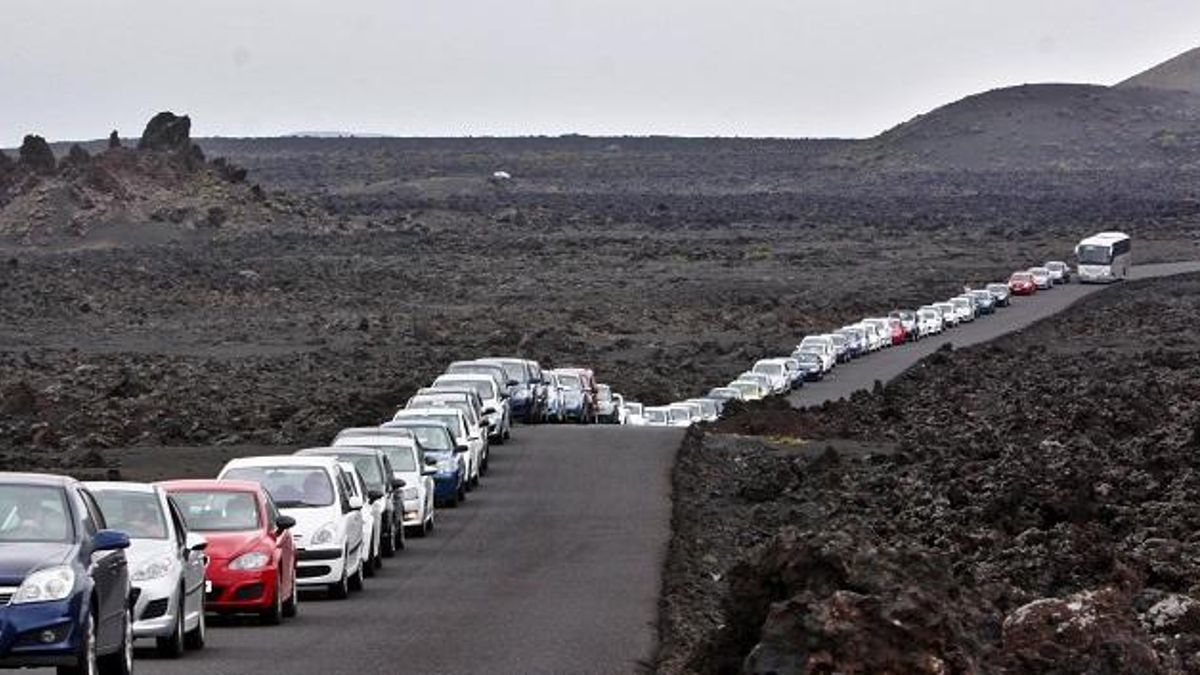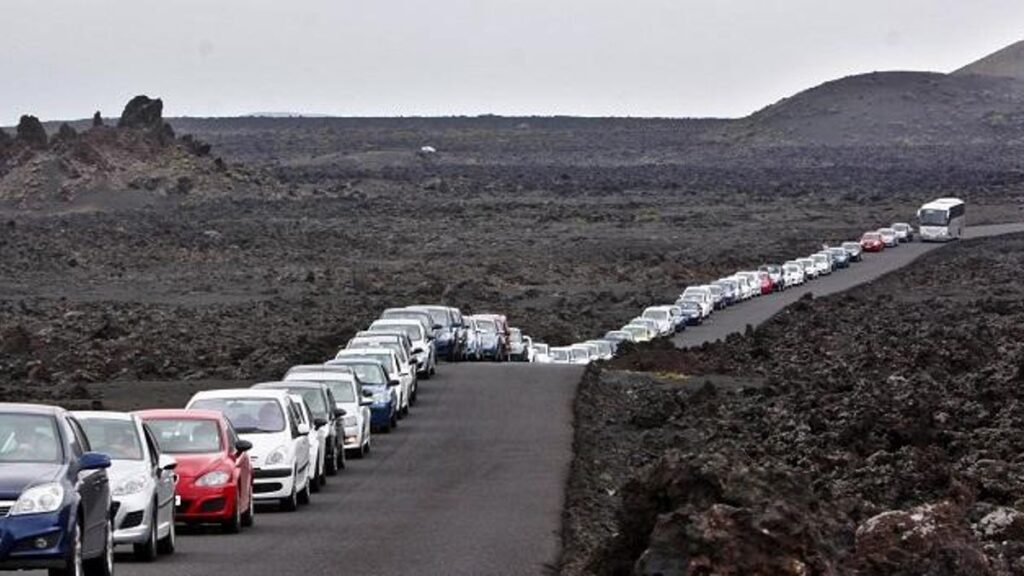A Fragile Paradise Under Pressure
The Canary Islands’ national parks, celebrated for their otherworldly landscapes and unique biodiversity, are showing clear signs of strain from mass tourism and climate change. In Teide National Park, the average coverage of the retama, its most emblematic plant species, has shrunk by 28.7% in recent decades due to rising temperatures and pressure from herbivores. The Tenerife Island Council acknowledges the “high” threat posed by the collection of endangered plants, like the silver thistle, and points to the “notorious” problem of “trampling and overuse” of the natural space by visitors, often “off the designated trails.”
Beyond Teide: A Widespread Problem
The impacts are not confined to the slopes of Spain’s highest peak. In Timanfaya on Lanzarote, the 2022 report from the Park Board states that the quality of the visit at some points is “severely diminished by excessive crowds.” The document emphasizes that “parking lots are congested, leaving no space for the circulation of people.” The carrying capacity of this site appears to have been exceeded, a fate shared by the Garajonay (La Gomera) and Caldera de Taburiente (La Palma) national parks, largely due to a recent surge in arrivals.
Record-Breaking Visitor Numbers
A staggering 8.4 million people visited the four Canary Islands national parks in 2024, the highest figure in historical records and an increase from the 7.7 million registered just a year before in 2023. Published this week by the Canary Islands Institute of Statistics (ISTAC), these numbers reveal a meteoric rise from the tourism standstill during the coronavirus pandemic in 2020, which saw a mere 3.3 million visits. The numbers climbed to 4.7 million in 2021 and 6.7 million in 2022, marking an unprecedented increase of over five million visitors in just four years.
Ecologists Sound the Alarm
“These figures clearly indicate that the pressure on our national parks, where biodiversity is immense within very small spaces, is being affected by an increase in visitors that shows no signs of stopping,” reflects Eustaquio Villalba, spokesperson for the Tenerife Friends of Nature Association (ATAN). He adds, “It is absolutely negative for our national parks to have such a high number of visitors if they are to be conserved in perfect condition.” This strikes at the heart of a national park’s primary legal objective: “to conserve the integrity of its natural values and landscapes, and, subordinate to that, the social use and enjoyment for all people.” Overcrowding is putting it all at risk.
The Specific Case of Teide National Park
In Teide, where visits increased by almost 800,000 from 2023 to 2024, Villalba explains that more people also mean more footsteps, more people going “off-trail,” and “cars occupying every roadside.” He states, “There is a direct impact on the very values for which Teide is a national park—its geology, fauna, and flora. In other words, its landscape.” Even the park’s new management plan, endorsed this week by the National Park Board, recognizes the need to “reinforce” activity surveillance protocols and implement systems to ensure the “correct functioning” of the park, especially in areas with a “higher-than-recommended” intensity of visits, such as the Teide crater or the pumice fields.
Calculating the Limits
Technicians tasked with determining the carrying capacity of Spain’s highest peak have divided its main attractions into five zones, setting a maximum daily number of visitors for each: the Roques de García parador (4,403 people per day), the cable car (3,816), the Teide peak (1,350), the Minas de San José-Montaña Blanca (1,028), and Portillo (3,706). This brings the total to 14,303 daily visits. Multiplied by 365 days a year, the annual capacity is 5.22 million entries. Last year, the park received precisely 5.24 million.
Criticism of Proposed Solutions
Villalba criticizes the situation, stating, “Teide National Park is a theme park where business is prioritized over land conservation.” He considers the flagship measure of the new management plan—a ban on private vehicle access during certain hours—to be an empty gesture if not backed by a decisive commitment to public transport, for which “absolutely nothing” has been done in years. He also questions the announced fee of up to €25, which has been presented as a condition for accessing the park but will, in reality, only apply to two of the 41 existing trails. “The proposal for shuttle buses has been discussed since the 90s. There’s nothing new. And the fee they say they will charge is pure demagogy to win elections, but certainly not to achieve a real solution,” laments the graduate in Geography and History from the University of La Laguna.
The Root of the Problem
Villalba concludes, “If you are promoting, increasing, and celebrating, as the authorities here do, that there are more and more tourists, how are you going to prevent the national parks, specifically the one in Tenerife, from having more visitors? You are putting a bandage where the wound is not. The wound is in the more than seven million travelers that Tenerife receives each year.”
A National Pattern of Overcrowding
Spain’s 16 national parks received a record 16 million visitors last year, and most have admitted to a serious overcrowding problem. In Garajonay, managers have warned of the “high number of vehicles causing traffic jams and safety issues.” In Caldera de Taburiente, the high volume of traffic to the Roque de los Muchachos parking areas is a concern. And in Timanfaya, access to the Las Montañas del Fuego tourist center “continues to have daily queues.”
Expert Perspective on Managing the Crisis
Juana Barber, a forestry engineer and current president of EUROPARC-Spain, an organization for professionals involved in managing the country’s protected areas, explains that the “national park” designation functions as a “worldwide brand” and is an increasingly powerful draw. However, she admits that “we cannot continue growing in this way” because the territory “cannot accept it,” meaning access will have to be limited somehow, even if it means saying, “Only these people can enter.”
Changing Visitor Profiles and Proposed Strategies
Barber details that the profile of the national park visitor has changed. The problem is not just quantity, but that many people no longer visit these natural spaces for their intrinsic values and now come primarily to take a photo. “They forget that what they are contributing is something that does not belong in that place,” she adds. Barber proposes zoning areas based on their fragility, directing visitors towards “less fragile” zones to reduce pressure on sensitive areas. This could be achieved by distributing other points of interest on the periphery of the protected natural spaces. She clarifies that the goal is not to have “everyone everywhere,” but to control visitor flow better. She also supports restricting car access and prioritizing public transport, a measure she believes society must accept because “we have no other choice.” Such limitations, Barber continues, cannot be implemented abruptly but must be introduced “little by little” to consolidate new habits. “We are creatures of habit,” the expert concludes.
What Measures Are Actually Working?
According to the document “Tools to Avoid Overcrowding,” the most effective measures among national parks appear to be access control (affirmed by six managers), promoting public transport (two), implementing a booking system (two), limiting the number of people (one), and restricting parking spaces (also one). The search for a sustainable balance between enjoyment and preservation continues, but time is of the essence for these fragile island ecosystems.


